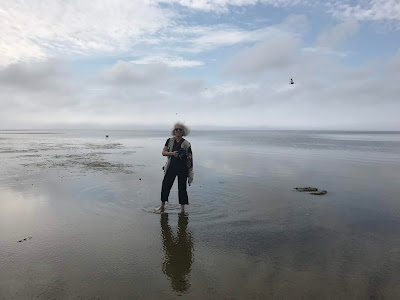#MeetHeraartistKathieFlorsheim
Tell us your artist story, some biographical info, when did you decide to be an artist? Why do you make art? Where did you study? Etc.
I am not sure I decided to be an artist. The decision crept up on me when I was an undergrad, taking design, photography and sculpture classes. I thought those classes were gut courses, a respite from all the reading required of a history major. Little did I know…. Soon I was spending all my spare time in the bronze-casting studio on the heels of taking a year of design classes. By the time I graduated, I was hooked and itching to make things- not to delve farther into modern European history. Nonetheless my undergraduate education taught me how to ask a question, and how to look for the answer. That has been essential in my studio practice.
The pleasure of Making is the most exciting thing I can think of doing, in this or any other lifetime. Whenever I daydream about other professions, like marine biology or something similar, I can’t imagine being away from my studio or the process of making things. I love having space, both physically and emotionally, to fiddle around with ideas. For me the process is as important as the finished object.
My education is a bit off the beaten track. I was a history major at Mt. Holyoke College in western Massachusetts, followed by two years at as an undergrad at California College of Arts and Crafts (CCAC) in Oakland, California. Then I came to RISD for an MFA in photography. I thought I would be a sculptor when I went to CCAC but the sculpture department was full of casting all-stars, all male and not friendly to women. It was a closed shop, which was not the case in the photography department.
The first day of photography class at CCAC, the assembled crowd exceeded the allowable size of the class. To pare the class down, the instructor went around the room, asking each of us why we were there. I said, “Because I have to be.” She let me stay. On our first photo field trip, I got a cactus stuck in my forehead, had to have a tetanus shot, and refused to tell my doctor why I appeared in his office with mercurochrome covering my forehead. Adding insult to injury, one of my classmates thought it was a good idea to photograph me rather than to remove the cactus spines.
I started out using a 35 mm camera, but moved on to a 4x5 Crown Graphic and eventually moved to a medium format twin lens Rollei with which I made the images that got me into grad school. I applied to RISD because Aaron Siskind was teaching there, spent two years there learning how not to critique images – there was nothing kind or particularly useful that came out of the crits in grad school. I had to learn how to do a responsible crit for the benefit of my students after I graduated. I didn’t fall in love with photography until well after graduate school.
What do you want people to walk away with after experiencing your work?
I am making the seascapes in the series Room 10 because I am interested in how light alters space over water. I follow my nose as I go. These images are hard to make, harder to edit. I am doing them because. I am told they are calming and serene. Once I have completed the process of making them, I can see that. But I am not making them with that intention. I don’t make them with the viewer in mind. I am making the Because.
The climate change work I am doing in my two series On the Edge and Living on the Edge is intended as a chronicle, a way to document what we are doing along the shore. I want to call attention to land use in those places-because so much of it is absurd, and destructive, and the beat goes on, as we continue to approve and build structures in flood zones. If I bare witness to this absurdity, and pass along my distaste and distain for the disrespect accorded to that luminal space, I will sleep well at night.
What influences your work? Why?
Music and calligraphy and daily living are what influence me. Music and calligraphy have taught me a lot about graphics, shape and color. I have spent a lot of time living inside of music I love. I can’t explain how I do this, I can only say I enter the music.
I studied piano as an undergrad, seriously studied it. I was not a good pianist, but I learned a lot about phrasing, shaping and coloring sound and that has been determinant in my work. That knowledge, for me, translates well into a two-dimensional image. Music also teaches me, repeatedly, how to start and how to end a sequence of images that I want to show.
Studying calligraphy enriched what I learned from music. Good calligraphy demands that graphic and spatial placement work simultaneously – it is very satisfying and a great and demanding task master. Whenever I go to a concert, I know I am in the right place when my thoughts merge into calligraphy as I listen.
What does it mean to you to participate in Hera, either as an artist member OR as an exhibiting artist?
I am a member of Hera because the gallery is a community. I also admire the courage to take on shows that would be unlikely in other places. Our shows are varied and challenging. Making work can be isolating, but Hera offers an opportunity to trade ideas and expose one’s self to what other artists are doing. I also like being involved in the nuts and bolts of how work is displayed.
To view Kathie's work visit her website:


.jpg)
Comments